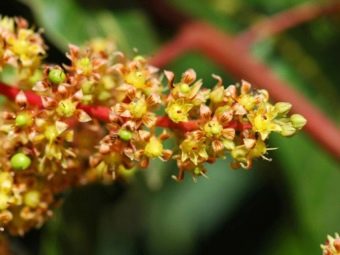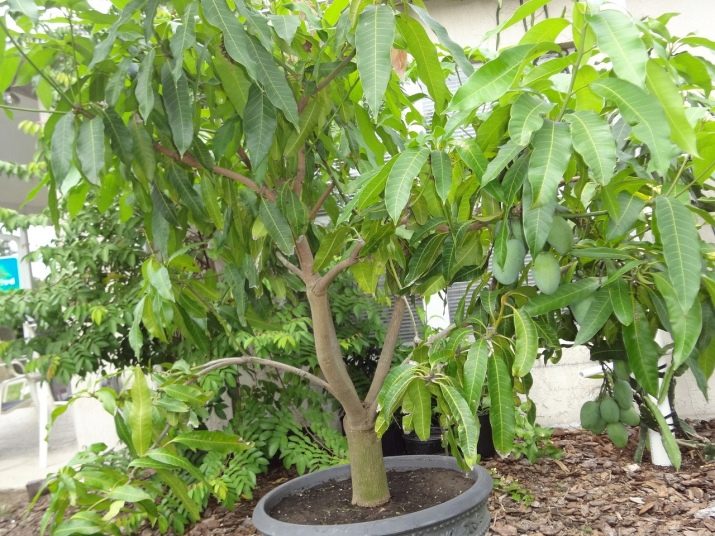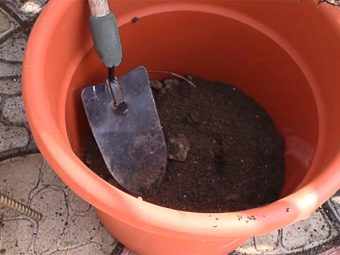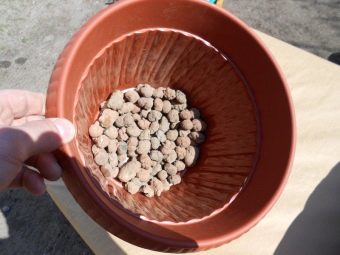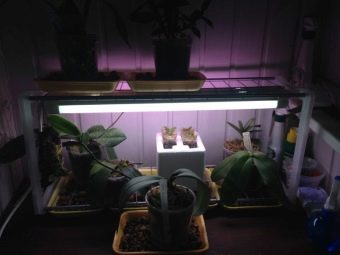How to grow a mango from the stone at home?
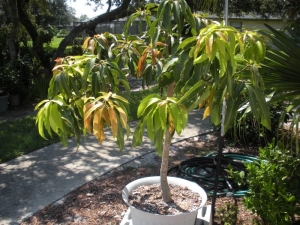
Such an exotic fruit, like mango, has long been loved by residents of many countries. After eating its juicy pulp remains a large bone.Many simply throw it away, but you can plant it and grow an overseas tree at home. How to do it, we will tell in this article.
Features of culture
The exotic fruit of the mango, which is loved by the inhabitants of many countries of the world, comes from India and Pakistan. An interesting fact is that in the world there are more than three hundred varieties of mango trees. But those who give sweet fruit, only 35. Plants give a variety of fruits. Mango may well be not only yellow or reddish, as everyone is used to, but also green. By the way, the green fruit is considered the most delicious.
The taste of this fruit can not be described in two words. Someone thinks that it resembles a combination of peach and carrot, someone manages to catch a touch of pineapple and even strawberries. Mango has a unique taste, which is accompanied by a light pine aroma.
An evergreen tree can grow to a height of more than forty meters. Mango tree fruits are quite large, up to 20 centimeters in length. The weight of 1 piece, as a rule, can reach 500-700 grams. Each fruit is fraught with beneficial properties, and regular use of this fruit can replenish the body's reserves with a variety of vitamins and elements.
This plant is very fond of the sun and can even die at + 5 °. The roots of a tree grow large and go to a depth of five meters. The tree grows beautifully, with spreading branches, large leaves. And during flowering all branches strew with delicate flowers. By the way, a mango tree can be considered a long-liver as it grows and bears fruit for more than two hundred years.
How to grow at home?
Having used the most tasty fruit, there is a large stone. Do not rush to send it to the trash. After all, at home it is quite possible to grow a small tree, which will delight with its beauty.
It is possible to grow from a stone a wonderful plant that will decorate a house. Of course, such a mango tree is unlikely to bear fruit at home. But many manage to achieve the fact that after five or six years it begins to bloom and produces small fruits. To achieve this success, you need to be patient and carefully take care of the plant, surrounding it with care and warmth.
It is possible to grow a tree from a bone of a juicy exotic fruit only if you know all the subtleties and tricks of the process, which we will discuss later.
Training
First you need to separate the bone from the pulp. You need to choose a ripe fruit, not overripe. If you like these exotic fruits, then you probably know that ripe ones smell like turpentine, but overripe ones carry the smell of alcohol. Mango bone is easily separated from the pulp in the event that the fruit is mature. If he is a little unripe, then the bone will be covered with a small amount of pulp, which can be easily removed with a sharp knife.
The bone should be thoroughly rinsed with cool running water so that no pulp and juice remain on it. In order to germinate a seed as soon as possible, it is necessary to remove it from the shell. Use a thin and sharp knife to open the bone, carefully remove the seed from there. Everything should be done as carefully as possible so as not to damage it.
The seed resembles a large bean. Try not to damage it, do not touch the knife. In the event that the bone is very hard, then in no case break it. So you only damage the seed, and it will no longer be suitable for planting.
Place a hard bone in a container with clean cold water and leave it there for two weeks. As soon as it swells, you can easily open it and get the whole seed.
After the seed is in your hands, be sure to treat it with some fungicide to destroy all harmful bacteria and fungi. Thanks to this simple procedure, the seed will be ready for germination and will not rot. Next you need to wrap it in a small piece of cloth or paper towel. Remember that the fabric should be light and breathable.Pre-cloth or towel should be slightly wet. Do not dampen the cloth too much, and a paper towel is best sprinkled with cool water to prevent it from getting cold. If the tissue is too wet, the process of decay will begin.
Wrapped seed should be placed in a tight bag. For this case, a perfect package with a special clasp, which is designed to store vegetables and fruits in the freezer. It has good density and it does not allow air, helping to create a greenhouse effect for the future sprout. Also suitable for a greenhouse plastic container with a tight lid. Just remember that it should be clean, free of odors and always from food-grade plastic.
This kind of greenhouse should be placed in a dark place away from sunlight. Do not forget to regularly check the humidity, opening the container or package. In case of drying, slightly moisten the cloth or paper towel. By the way, if the house has sawdust, then you can put the seed right into them. Pre-sawdust to moisten. It is not necessary to clean such a “greenhouse” in a dark place, as the future sprout will be already hidden from the sun.
After two or three weeks, the first sprout appears. By this time, we can confidently say that the seed is ready for planting.
In the event that there were no signs of life within a month, there are no germs, then most likely something in your actions was wrong and the seed could not germinate.
When and how to plant?
Planting a future mango tree also requires compliance with certain rules. Of course, you can immediately plant the seed in the ground and start growing it in a pot at home, but it is better to do otherwise. The fact is that when a germinated seed is immediately planted in the ground, this does not always give a result. Most often, this method is ineffective, the seed does not grow, begins to rot inside the earth and all efforts are in vain. In order to achieve results and grow a beautiful tree, we recommend that you properly prepare everything for planting.
To get started, get a spacious pot so that the plant can develop in the same way as in natural conditions. It is not recommended to replant this plant often, as it damages its root system.
In a spacious and large pot lay out drainage, that is, fill the bottom with small stones five centimeters. Proper drainage will help the future tree to grow, breathe, and save from possible decay of the roots. Next, fill the pot with the substrate. It needs so much to fill 2/3 capacity. The soil for an exotic plant should be light, with a neutral pH. It is best to choose a universal primer.
Before falling asleep, be sure to check the level of acidity with the help of indicator strips.
After doing a small depression so that you can plant a seed there. The fossa should not be deeper than three centimeters. If the sprout has already appeared, then you need to plant a seed sprout down. If it has not yet appeared, or you decide to plant the seed without prior germination, then you need to plant it with the flat side down. This is extremely important.
As soon as the seed is inside the earth, moisten it. You only need to moisten with a spray bottle so that the earth is not too wet. Then cover it with a plastic dome cover. A similar transparent container or half of a cut plastic bottle will also work.
Such a greenhouse should cover the future plant until the first sprout appears. It will take about two or three weeks. During this period it is very important to regularly moisten the earth by lifting the lid. Again, this should be done with a spray gun. Removing the "roof" over the future sprout for five minutes a day is necessary in order to moisten the earth and air it, otherwise the process of decay may begin and the plant will die.
During this period, the pot should be in a warm and bright room, but direct sunlight should not fall on it.Remember that the excess sun can adversely affect the growth of a future tree or even destroy it at the initial stage.
Once under the "greenhouse" you see the first sprout, the cover can be removed. Sometimes it happens that several leaves appear at once and they are of different colors. This frightens many, and they immediately begin to pinch off not green leaves, but it is absolutely impossible to do this. Different leaves are the norm for a small mango sprout. They can be not only green, but also darker, even purple.
So, the sprout has appeared, and the first successful step towards your dream has already been made. Next you need to ensure the plant the right care.
Care
Mango growing at home is not an easy process. An exotic plant requires special treatment, special conditions and great patience. Care for him just like a potted flower, watering it every two days, will not work. This tree is capricious, so be prepared to properly care for it and provide it with proper attention.
Let's start with the fact that an exotic tree needs proper lighting. As soon as the sprout gets stronger, it will no longer be afraid of direct sunlight. Therefore, if you leave it under the sun on the window sill, nothing bad will happen to the plant. But if he does not have enough heat and light, it will gradually throw off the leaves, and after that it may even die. In winter, many cities and regions are sorely lacking in the sun. Therefore, the tree will have to be fed with the light of a fluorescent lamp for twelve hours a day.
As for the comfort temperature for mango, it should be no more than + 26 °, but not less than + 21 °. Try to grow a tree in one room with a stable, comfortable temperature for it. Many people make a mistake when in spring or summer they periodically put the plant on the balcony, and then bring it back into the room.
Mango does not tolerate sudden changes in temperature, does not like to change climatic conditions, does not like a strong wind, and even more so is afraid of rain. Therefore, frequent and abrupt climate change can lead to the death of the plant.
In order for the tree to grow healthy and develop properly, it needs to be watered regularly. In no case should not allow drying of the earth. Water an exotic plant two or three times a week. It all depends on your weather conditions. At the same time, remember that it is impossible to transfuse a plant, since rotting of roots can begin due to an excess of moisture. Watering a tree needs only settled water.
You should also control the humidity in the room where the mango will grow. If the air is dry, it will adversely affect the health of the plant. At any time of the year, do not forget to moisten the leaves by spraying them with clean water from a spray bottle. Remember that the humidity level in the room should be 70-80%. The ideal option in this case would be to purchase a humidifier, which is recommended to be installed next to the plant.
Like any plant, mango needs regular feeding. Remember that you only need to choose natural organic fertilizers. In order for the tree to grow well, it is necessary to add humus to the soil. Make it easy. At a short distance around the tree you need to make a groove, put humus there, and fill it with soil on top. Feed the plant with various dressings should be regularly, once a month. It is advisable to choose for this a particular day, for example, the first day of the month. Choose a nitrogen-rich feed for your mango. This will help the tree grow healthy and provide the correct growth, development and color of the leaves.
If you properly care for an exotic tree, it will start to grow rapidly upwards. Of course, at home it is not permissible, so it is worth it to cut it in time. Initially, as soon as 8-9 leaves appear on the seedling, you need to pinch the top of the head.Once the plant reaches a length of one and a half meters, you can begin to form its crown. Pruning the branches of the plant should be in early spring, leaving only the five most powerful. As soon as the extra branch is removed, the cutting place must necessarily be treated with a special garden pitch.
In the event that you have planted your exotic plant in a small pot, then after the emergence of sprouts you should not rush to transplant. It is possible to replant a tree in a more spacious container only in a year, when it will get stronger.
If a year later you are looking for a new mango pot, then remember that it should be not only wider, but also deeper. As soon as a tree is three to five years old, it can be safely transplanted into a deeper and wider pot, if necessary. Transplantation is not recommended more often than once every three years.
In order for the tree to begin to bear fruit, it is not enough that you will properly care for it. Home plants of this type very rarely produce fruit. If desired, you can plant a plant, and after two years it will begin to bloom and give its first fruits.
Remember that it is better to plant this home plant in summer. Of course, subsequent reproduction of such a grafted tree is allowed, if necessary.
Even in the absence of fruits, this exotic plant will become an unusual decoration for your home. For information on how to grow a mango from a stone, see the video below.







